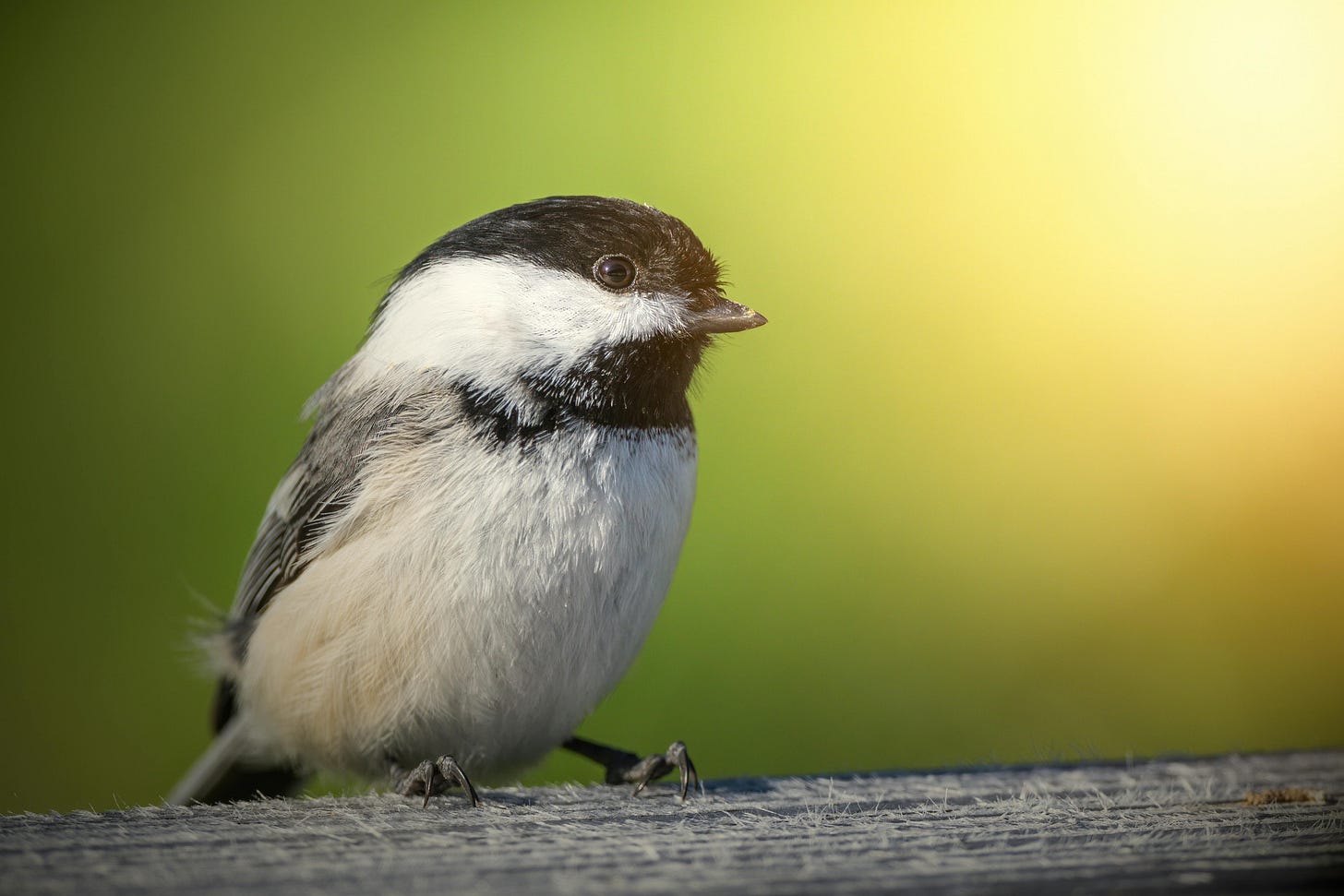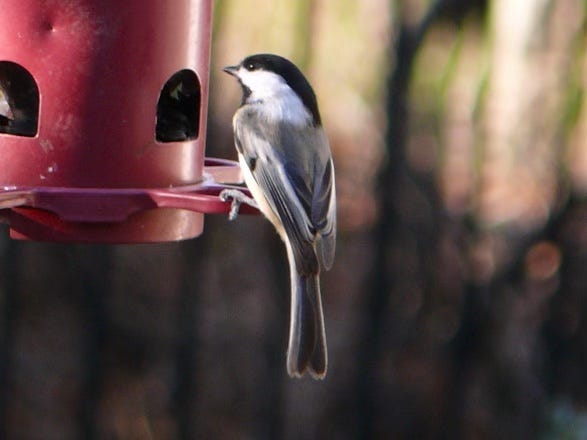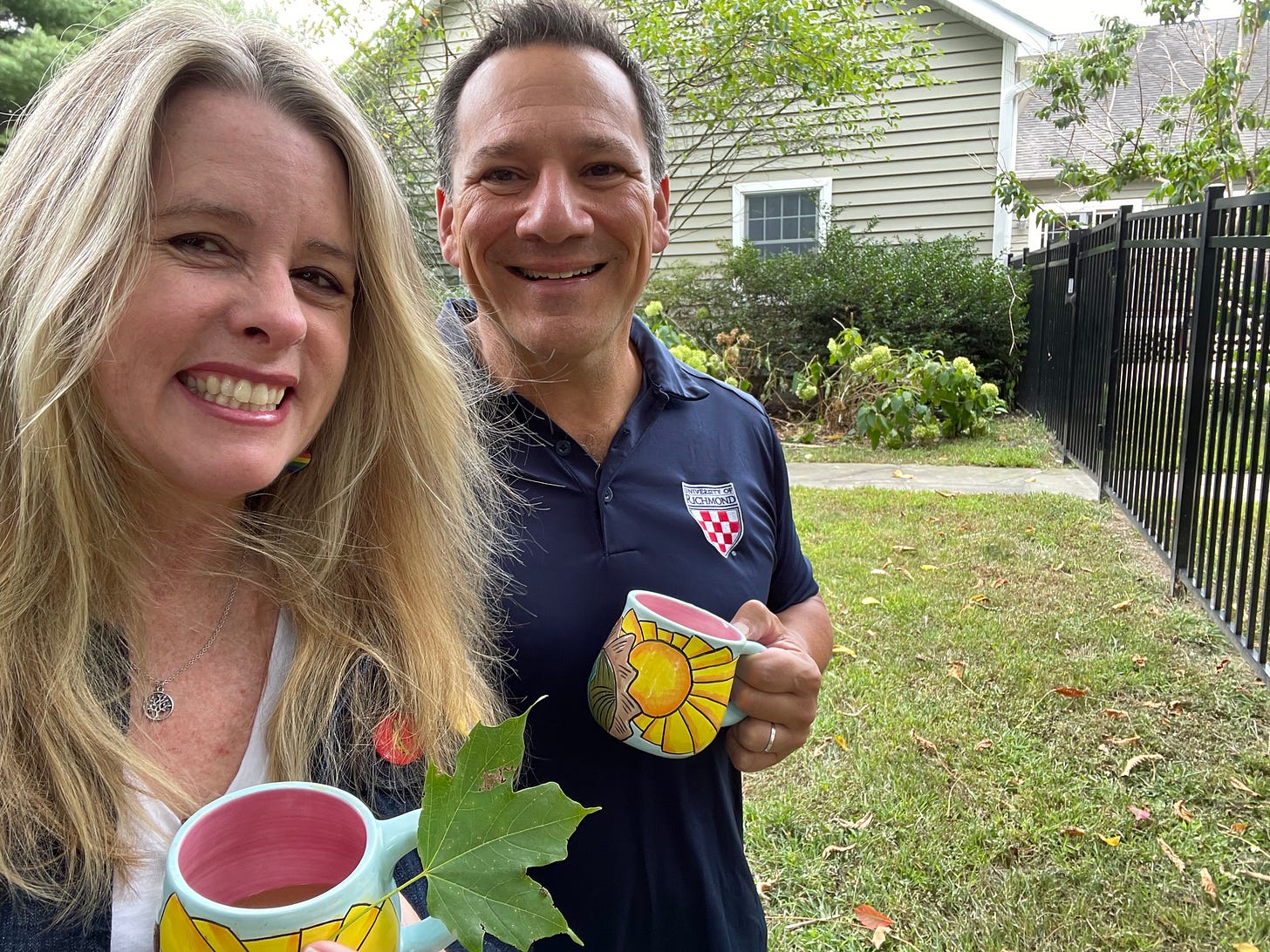The Courage of the Black-Capped Chickadee
What a tiny bird taught us about living a courageous life
(Photo: Pexels/Skyler Ewing)
Our Daily Ritual
Each morning, after making coffee, we fill the distinctive, barn-red bird feeder that hangs down between our back deck and Illinois Mountain. We whistle and hum and call the birds in as if we’re in a Disney movie.
As we fill the feeder (using a funnel we handmade from an old piece of watercolor paper), we whistle to signal to the birds: Spread the word; the bird buffet is open!
Given the dense bird population in the Hudson Valley and the highly natural environment surrounding our home, we’re fortunate to have a broad array of beaked visitors every day.
The songbirds at the feeder are the equivalent of our pets. When it’s snowing, we sit inside and watch them, and on warmer days, under the rays of the upstate New York sun, we join them on the back patio, just a few feet from where they dine.
Often, we serenade them with our acoustic guitar, and they join the chorus. Sometimes, we let them do the singing.
We open up our favorite bird-call app (Merlin, for all you bird lovers out there) and watch as it identifies old favorites we know (Hello, Cardinal, and Red-Wing!) and those we don’t recognize (Ovenbird? What are you doing here?)
This daily ritual is one of our greatest joys.
Who Will be First to the Feeder?
We delightedly discuss the backyard bird activity as if we’re gossiping.
Which birds prefer to eat directly from the feeder and which prefer to graze on the ground? Why is that one rolling around in the dirt? Which birds seem to come in pairs (or, in the case of the house finches, in a family of three)? Don’t you think Mr. and Mrs. Finch are the best parents? How fast do you think mourning doves can fly, since they’re so big? (Answer: 55mph!)
One question we always ask is this: Who will be the first to the feeder? What brave bird will be the first of the day to take from this clearly human-made and maintained structure, only feet away from two primates who dwarf them in size?
You’d think it would be the large, muscular woodpecker, which can hang upside-down while it eats. Or the Blue Jay we call “LL Blue Jay,” with his confident stance.
Are you in complete suspense, like we are every morning?
Darling, graceful, sweet, and shockingly brave, just inches from where we’re sitting, swoops in the (perfectly named) Black-Capped Chickadee!
Naturally, we wondered, “Why would a bird so small be the first?”
Well, being an ever-curious couple, one of us being a behavioral evolutionary scientist, we knew how to find out.
It turns out that this feisty little bird's behavior perfectly matches the scientific research on its nature (see Belinsky, 2024).
(Photo: Sophia Guyton)
Why the Black-Capped Chickadee is First
In David Wilson’s highly acclaimed book, Evolution for Everyone, he dissects, in detail, the nature of flight distance in various non-human species.
Flight distance (c.f., Wilson, 2007) is how near a wild animal will get to a human before taking off or running away. Some wild animals allow humans to get close (a short flight distance), and others leave a ton of space between themselves and humans (a large flight distance).
Next time you spot a fox in your yard, see how close it lets you get to it. Odds are, it’ll be deep in the woods by the time you open your camera app.
One of the reasons we love the Black-Capped Chickadee relates to its flight distance. Our back deck is modest in size. For this reason, we're just a few feet from the feeder when we’re out there working (or painting watercolors, singing, or just enjoying nature—common occurrences in our world).
From this close perspective, we see differences in the flight distance across various bird species first-hand.
When we open the screen door to fill up the feeder, a flock of mourning doves might book it up to the tops of the maple trees. Mr. and Mrs. Cardinal will usually quickly swoop to the lilac tree in the far corner. Even LL Blue Jay will usually make a run for it.
But Black-Capped Chickadees are different. Sure, they have a startle response and sometimes bolt when we emerge. But they also seem to trust us, as if the Black-Capped Chickadees in our yard have come to learn that we’re friendly. These little ones have what we could call a relatively small flight distance.
On more than one occasion, we’ve had a banditry (what a group of Black-Capped Chickadees is called—for real!) grazing at our feeder for hours on end as we work next to them.
The Black-Capped Chickadee Personality Type
If we make the leap from bird to human and think of there being a “Black-Capped Chickadee Personality Type” (humor us!), what would be its core features? And what benefits would flow toward such an individual?
Well, based on the Black-Capped Chickadees that flutter between us and the mountain, we can paint some of the features of this kind of person in broad strokes.
Courageous: The Black-Capped Chickadee is brave—its core feature, in fact, seems to be courage itself. It doesn’t care about the fact that it may not be the largest or most formidable. It’s been shown that risk-taking is necessary for courageous action (Garcia et al., 2023), and the Black-Capped Chickadees have this quality (Mathot et al., 2022).
Socially Aware: The Black-Capped Chickadee also seems to care about the social features of its world. It’s rare to see a single Black-Capped Chickadee in the yard. If you see one, there are probably at least five or so hanging around. And as a great deal of research in evolutionary behavioral science tells us, there is strength in numbers. This fact has been true for lots of animals, including humans, for thousands of generations (see Bingham & Souza, 2009).
Flexible in Decision-Making: The Black-Capped Chickadee may be brave, but it’s not stupid. If a predator (e.g., a hawk flying overhead or a cat prowling around the yard) shows up, the Black-Capped Chickadee will pay attention and take appropriate action. They have not survived millions of years of evolution by being foolish—they base their actions on the details of the situation. In a word, they are flexible.
Relatively Non-Aggressive: The Black-Capped Chickadee doesn’t want to get into it with other bird species. They’re unlike those Blue Jays, Pileated Woodpeckers, or Starlings who clear everyone out of the way when they conspicuously arrive at the feeder. The Black-Capped Chickadee is not looking for trouble. Just a nice snack underneath the Hudson Valley sunshine.
This suite of personality traits has been effective for these birds for an excessively long time. Maybe we humans can learn a thing or two from these courageous little birds.
Harnessing Your Inner Black-Capped Chickadee
Certain types or roles emerge in any team, be it a work team or within a family or friend group. Seeing types of people as birds is illuminating (and fun!).
The “Caretaker” is the leader who messages anyone at work after 7 p.m. to please go home—we’ll call them a Mourning Dove. They’re pretty chill and truly care about work/life balance.
The “Rule-Breaker” is the one who pushes the limits and can be heard saying, “Employee manual? What employee manual?” We’ll call them a House Sparrow (accidentally in North America, by the way (see Summers-Smith, 1988)).
The “Showboat” is the one who brags about their recent accomplishments—we’ll call them the Cardinal. (If you haven’t seen this impersonator of a Cardinal doing a photo shoot on a winter day, we highly recommend it!)
We could go on, but we’ll end on our main subject of the day:
The team member, leader, or friend who is first into the fray—the first to raise their hand with an idea to get the ball rolling in a brainstorm, the first to offer to be the spokesperson for the group, the first to share their vulnerability to make it safe for others to do so: That is the Black-Capped Chickadee.
Bottom Line
As you can tell, we’re very fond of the Black-Capped Chickadee. They’re friendly, courageous, sociable, smart, peaceful, and unafraid.
People who show these same characteristics may well thrive in all kinds of situations. They likely do well socially, as sociability is a core element of their nature. They are courageous and, thus, can be counted on to take important actions and lead the way for others. And they are kind—they stay out of trouble and tend to stay in their own lane. What do they care if a house finch family gets a nice meal also today? There’s enough for everyone.
Want to be a courageous leader and thrive in your life? We say that you should try to harness your inner Black-Capped Chickadee.
Your courage, coupled with your kindness, will lead to all kinds of rewards as you navigate the often-turbulent skies of life.
About the Authors
Glenn and Shannon Geher are professional writers inspired by their extraordinary love and the everyday magic, wonder, and fun they cultivate living in Upstate New York.
By day, Glenn is a professor of psychology and director of Evolutionary Studies at the State University of New York, where he has won SUNY Chancellor awards for teaching, research, and service. He has two grown-up “kids,” Megan and Andrew, whom he adores, and loves being married to Shannon, his best friend, partner, and wife. He also plays guitar for the only all-professor punk rock band of the Hudson Valley, Questionable Authorities. Glenn loves birds.
Shannon is the current content director for Be Courageous, a boutique business consultancy that works with Fortune 1000 companies to unlock the power of courage for positive impact. Along with a rich career in digital marketing and editorial management with companies from WeddingChannel.com to TheBump.com, she has co-authored several memoirs, including It’s Not a Rumour: A Rock and Roll Journey Through Life and Alzheimer’s, among other award-winning nonfiction works. She’s incredibly proud of her two grown-up “kids,” Nathan and Sophia, and cherishes every moment of the loving life she shares with her husband, Glenn. Shannon’s nickname is “Cali,” named after a particular American Goldfinch.
References
Belinsky, K. (2024). A Bird's-Eye View of Suburbanization: Can We Build Better Towns and Villages for Wildlife and Humans? Lecture given in annual Evolutionary Studies (EvoS) Seminar Series at the State University of New York at New Paltz.
Bingham, P. M., & Souza, J. (2009). Death from a distance and the birth of a humane universe. Lexington, KY: BookSurge Publishing.
Garcia, S., Lopez, S., Longo, K., & Geher, G. (2023). Are we evolved to be courageous? A study of the psychological correlates of courage. Presentation given at annual meeting of the NorthEastern Evolutionary Psychology Society. April, New Paltz, NY.
Mathot KJ, Arteaga-Torres JD, Wijmenga JJ. Individual risk-taking behaviour in black-capped chickadees (Poecile atricapillus) does not predict annual survival. R Soc Open Sci. 2022 Jul 27;9(7):220299. doi: 10.1098/rsos.220299. PMID: 35911194; PMCID: PMC9326292.
Summers-Smith, J. Denis (1988). The Sparrows. Illustrated by Robert Gillmor. Calton, Staffs, England: T. & A. D. Poyser. ISBN 978-0-85661-048-6.
Wilson, D. S. (2007). Evolution for everyone: How Darwin’s theory can change the way we think about our lives. New York: Delacorte Press.








